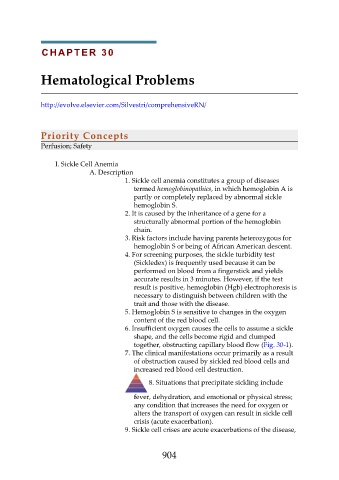Page 904 - Saunders Comprehensive Review For NCLEX-RN
P. 904
CHAPTER 30
Hematological Problems
http://evolve.elsevier.com/Silvestri/comprehensiveRN/
Priority Concepts
Perfusion; Safety
I. Sickle Cell Anemia
A. Description
1. Sickle cell anemia constitutes a group of diseases
termed hemoglobinopathies, in which hemoglobin A is
partly or completely replaced by abnormal sickle
hemoglobin S.
2. It is caused by the inheritance of a gene for a
structurally abnormal portion of the hemoglobin
chain.
3. Risk factors include having parents heterozygous for
hemoglobin S or being of African American descent.
4. For screening purposes, the sickle turbidity test
(Sickledex) is frequently used because it can be
performed on blood from a fingerstick and yields
accurate results in 3 minutes. However, if the test
result is positive, hemoglobin (Hgb) electrophoresis is
necessary to distinguish between children with the
trait and those with the disease.
5. Hemoglobin S is sensitive to changes in the oxygen
content of the red blood cell.
6. Insufficient oxygen causes the cells to assume a sickle
shape, and the cells become rigid and clumped
together, obstructing capillary blood flow (Fig. 30-1).
7. The clinical manifestations occur primarily as a result
of obstruction caused by sickled red blood cells and
increased red blood cell destruction.
8. Situations that precipitate sickling include
fever, dehydration, and emotional or physical stress;
any condition that increases the need for oxygen or
alters the transport of oxygen can result in sickle cell
crisis (acute exacerbation).
9. Sickle cell crises are acute exacerbations of the disease,
904

